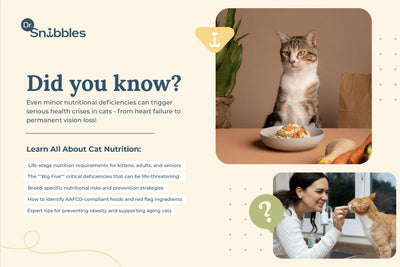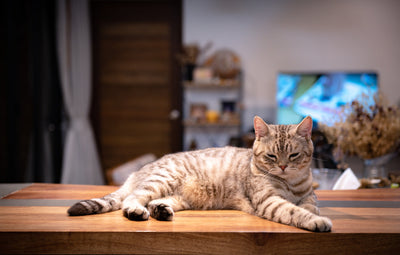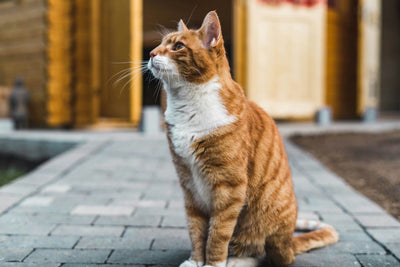What to Feed Your Kitten for Optimal Health [2025]
Bringing home a new kitten in India?
Get science-backed feeding guidance tailored for Indian pet parents. Learn exactly how much to feed kittens at 3-4 months, discover the best wet vs dry food ratios for India's climate, and find budget-friendly brand recommendations from ₹150-500/kg.
This comprehensive guide covers everything from AAFCO-approved nutrition standards to climate-specific feeding tips for different Indian regions. Avoid common mistakes like cow's milk feeding and free-feeding while building healthy eating habits that last a lifetime. Includes downloadable feeding schedules, growth monitoring checklists, and expert veterinary advice for optimal kitten development.
Key Topics: Age-based feeding schedules • Indian brand comparisons • Climate considerations • Scientific nutrition requirements • Common feeding mistakes to avoid
![What to Feed Your Kitten for Optimal Health [2025]](http://drsnibbles.com/cdn/shop/articles/Cat_Banner_resized_3ed7bb31-0221-42c1-b937-bd7dbd7cdf86.jpg?v=1759400268&width=1600)
ON THIS PAGE
The Bottom Line: Proper nutrition during kittenhood isn't just about growth—it's about building the foundation for a lifetime of health. With India's unique climate challenges and brand availability, choosing the right feeding approach for your kitten requires understanding both scientific principles and local realities.
Bringing home a new kitten is exciting, but many Indian pet parents feel overwhelmed by conflicting feeding advice. Should you buy expensive imported brands or trust local options? How much should a 3-month-old kitten eat in Mumbai's heat versus Delhi's winter? This comprehensive guide answers these questions with science-backed advice tailored specifically for Indian cat parents.
How Much Should You Feed Your Kitten? (Age-Based Guide)
The most searched question among new kitten parents: How much should a kitten eat? The answer depends entirely on your kitten's age, weight, and activity level.
📊 Complete Feeding Schedule for Indian Kittens
| Kitten Age | Meals Per Day | Amount Per Meal | Daily Total | Special Notes |
|---|---|---|---|---|
| 6-16 weeks | 4 meals | 25-50g | 100-200g | High-calorie focus, monitor closely |
| 4-6 months | 3 meals | 50-75g | 150-225g | Growth monitoring critical |
| 6-12 months | 2-3 meals | 75-100g | 150-300g | Pre-adult transition phase |
Climate Consideration for India: During summer months (March-June), kittens may eat slightly less dry food but require more water. In hot regions like Rajasthan or Tamil Nadu, increase wet food portions to maintain hydration.
How Much to Feed a Kitten 3 Months Old?
Three-month-old kittens are in their rapid growth phase. Feed 3-4 meals daily with 50-60g per meal of high-quality kitten food. Many pet parents on r/CatAdvice report that 3-month-old kittens can seem constantly hungry—this is normal! Their metabolic rate is incredibly high.
Weight Monitoring Tip: A healthy 3-month-old kitten should gain 100-200g per week. If your kitten isn't gaining weight consistently, consult a veterinarian immediately.
How Much to Feed a Kitten 4 Months Old?
Four-month-old kittens can transition to 3 meals daily with 60-75g per meal. This is when you can start reducing meal frequency while maintaining total daily nutrition.
What Makes Kitten Food Different From Adult Cat Food?
Understanding kitten nutrition science helps you make informed decisions, especially when choosing between premium imported brands and budget-friendly Indian options.

🧪 Critical Nutrients Spotlight
Protein Requirements:
- Kittens need minimum 30% protein (vs. 26% for adults)
- Must be animal-based protein - chicken, salmon, turkey as first ingredients
- Why this matters: Kittens are obligate carnivores with zero adaptation capacity for plant proteins
Fat Content:
- Minimum 9%, optimal 20-30% for growing kittens
- Provides concentrated energy for highly active growing bodies
- Delivers arachidonic acid - essential fatty acid cats cannot produce
- Supports brain development through DHA & EPA omega-3s
🔍 Myth vs Fact: Can Kittens Eat Adult Cat Food?
❌ Myth: "Adult food is cheaper and works fine for kittens"
✅ Fact: Adult cat food lacks sufficient calories, protein, and essential nutrients like DHA. Feeding adult food to growing kittens can cause developmental delays, poor coat quality, and compromised immune function.
How Often Should Kittens Eat? (Complete Feeding Schedule)
The science behind scheduled feeding: Kittens have tiny stomachs but massive energy needs. Free-feeding leads to overeating, digestive issues, and poor house training habits.
Why Scheduled Feeding Works Better in India
Pest Control: Scheduled feeding prevents attracting ants, cockroaches, and other insects common in Indian households.
Temperature Management: In hot climates, wet food spoils quickly. Scheduled feeding ensures fresh food at each meal.
Multi-Pet Households: Many Indian families have multiple pets. Scheduled feeding ensures each animal gets proper nutrition.
📱 Daily Feeding Schedule Template
6-16 Week Old Kittens:
- 6:00 AM - Morning meal (¼ daily portion)
- 12:00 PM - Lunch meal (¼ daily portion)
- 6:00 PM - Evening meal (¼ daily portion)
- 10:00 PM - Night meal (¼ daily portion)
4-6 Month Old Kittens:
- 7:00 AM - Breakfast (⅓ daily portion)
- 2:00 PM - Lunch (⅓ daily portion)
- 8:00 PM - Dinner (⅓ daily portion)
Best Kitten Foods Available in India: Commercial vs Homemade
The honest truth: Commercial kitten food is scientifically superior to homemade diets for growing kittens. Here's why, plus practical Indian brand recommendations.
Why Commercial Food Wins: The Science
Nutritional Completeness: Every ingredient is measured and formulated by veterinary nutritionists. Homemade diets often lack essential nutrients despite best intentions.
Complex Requirements: Some nutrients are needed in nanogram amounts—impossible to measure accurately at home.
Safety Standards: Commercial foods undergo feeding trials and quality control that home kitchens cannot replicate.
Veterinarians consistently recommend commercial diets because the risk of serious nutritional deficiencies is high with DIY approaches.
🇮🇳 India-Specific Brand Guide
Premium Tier (₹300-500/kg)
- Royal Canin Kitten - Widely available, excellent digestibility
- Hills Science Diet Kitten - Great for sensitive stomachs
- Purina Pro Plan Kitten - High protein, good value
Where to Buy: Amazon, pet specialty stores, veterinary clinics
Budget Tier (₹150-250/kg)
- Whiskas Kitten - Most accessible across India
- Me-O Kitten - Good nutrition at reasonable price
- Drools Kitten - Indian brand with improving quality
Availability: Local pet stores, supermarkets, online platforms
Specialty Products for Specific Needs:
- FortiFlora (probiotics) - Available through vets, ₹800-1200
- Nutrical (high-calorie supplement) - Pet stores, ₹600-900
- Royal Canin Gastrointestinal Kitten - For sensitive digestion, vet clinics
How Much Wet Food vs Dry Food Should Kittens Eat?
The optimal approach: Combine both wet and dry food for maximum nutritional benefit, especially important in India's varied climate conditions.
Benefits of Wet Food in Indian Climate
- Hydration Support: Critical during hot summer months when kittens may not drink enough water.
- Palatability: Helps picky eaters get adequate nutrition.
- Easier Digestion: Gentler on developing digestive systems.
Recommended Ratio: 60% wet food, 40% dry food for optimal hydration and nutrition.
Benefits of Dry Food
- Dental Health: Mechanical cleaning action helps prevent early dental issues.
- Convenience: Doesn't spoil quickly in hot weather.
- Cost-Effective: More economical for daily feeding.
- Storage: Easier to store in humid climates without spoilage.
📊 Practical Wet vs Dry Combination
For 3-Month-Old Kitten (Daily):
- Wet food: 2-3 pouches (85g each) = 170-255g
- Dry food: 30-50g
- Total calories: Approximately 300-400 calories
Common Kitten Feeding Mistakes Indian Pet Parents Make
One common mistake new kitten owners make is following well-meaning but outdated advice from family members or neighbors. Let's address the biggest myths with scientific evidence.

❌ Mistake #1: "Kittens Can Drink Cow's Milk"
The Reality: Most cats lack significant levels of lactase after weaning (6-8 weeks). Cow's milk causes diarrhea, gas, and bloating.
Indian Context: Buffalo milk, common in rural areas, has even higher lactose content and causes worse digestive upset.
Safe Alternative: Kitten milk replacer (KMR) available at vet clinics for ₹400-600.
❌ Mistake #2: "Raw Chicken is More Natural"
The Reality: Raw meat carries significant health risks—Salmonella, E. coli, Listeria. This is especially dangerous for young immune systems.
Indian Hygiene Concerns: Power cuts, high temperatures, and storage challenges make raw feeding particularly risky in Indian conditions.
Better Approach: High-quality commercial food provides all benefits of meat protein without contamination risks.
❌ Mistake #3: "Free-Feeding is Convenient"
The Reality: Free-feeding increases overnutrition risk and creates behavioral problems.
Many pet parents on r/CatAdvice report that free-fed kittens become overweight adults with poor eating habits.
India-Specific Issues: Attracts pests, food spoils quickly in heat, impossible to monitor individual intake in multi-pet homes.
❌ Mistake #4: "Vegetarian Diets Are Healthier"
The Reality: Cats are obligate carnivores. Plant-based diets cannot supply sufficient taurine, vitamin A (preformed), or arachidonic acid.
Serious Health Risks: Dilated cardiomyopathy, retinal degeneration, blindness, and death.
Cultural Sensitivity: While vegetarianism is respected in Indian culture, cats have no biological choice—they must consume animal protein to survive.
When to Switch From Kitten to Adult Food
Timing is crucial: Most kittens transition to adult food at 12 months, but larger breeds may need kitten food until 18 months.
Signs Your Kitten is Ready for Adult Food
✅ Reached adult size (typically by 10-12 months)
✅ Weight gain has slowed to normal adult maintenance
✅ Energy levels have stabilized (less hyperactive)
✅ Eating habits are established and consistent
The 7-Day Transition Method
- Days 1-2: 75% kitten food + 25% adult food
- Days 3-4: 50% kitten food + 50% adult food
- Days 5-6: 25% kitten food + 75% adult food
- Day 7+: 100% adult food
Monitor throughout: Watch for digestive upset, changes in appetite, or energy levels.
🚨 Critical Foods to Avoid - India-Specific Warnings
Never feed kittens these common Indian household items:
- Onions & garlic (common in all Indian cooking)
- Chocolate & sweets containing xylitol
- Grapes & raisins (including kishmish)
- Spices like turmeric, chili, garam masala
- Raw fish from local markets (contamination risk)
- Adult cat food or dog food
- Human medications including Ayurvedic preparations
Growth Monitoring: Signs of Proper Nutrition
✅ Signs Your Kitten is Thriving
Physical Indicators:
- Steady weight gain (100-200g weekly for kittens under 6 months)
- Glossy, soft coat without dullness
- Bright, clear eyes with no discharge
- Pink gums and good dental development
- Normal elimination (firm stools, regular urination)
Behavioral Indicators:
- High energy levels appropriate for age
- Curious, playful behavior
- Good appetite at meal times
- Normal sleep patterns
- Social interaction with humans/other pets
🚨 When to Consult an Indian Veterinarian
Immediate concerns:
- No weight gain for 2+ weeks
- Diarrhea lasting more than 24 hours
- Vomiting after meals
- Lethargy or hiding behavior
- Difficulty breathing or eating
Finding Quality Veterinary Care: Use platforms like Vetstation, JustDoc, or local veterinary associations to find qualified professionals in your area.
Climate-Specific Feeding Tips for Different Indian Regions
Hot Regions (Rajasthan, Tamil Nadu, Andhra Pradesh)
- Increase wet food ratio to 70%
- Provide multiple water sources
- Feed during cooler parts of the day
- Store dry food in airtight containers
Humid Regions (Bengal, Kerala, Assam)
- Monitor food for mold/spoilage
- Use smaller portions more frequently
- Ensure proper ventilation in feeding areas
- Consider dehumidifiers for food storage
Cold Regions (Himachal, Kashmir, Hill Stations)
- Slightly increase caloric intake
- Warm food to room temperature before serving
- Provide extra fat content for energy
- Monitor for adequate weight gain
📋 Your Kitten's Nutrition Success Checklist
Essential Action Items:
- Choose AAFCO-approved kitten food with animal protein as first ingredient
- Feed 4 meals daily for 6-16 week old kittens, reduce frequency as they grow
- Combine wet and dry food (60/40 ratio) for optimal hydration
- Monitor weekly weight gain and body condition scoring
- Avoid cow's milk, raw diets, and adult cat food completely
- Plan gradual transition to adult food at 12+ months
- Establish relationship with local veterinarian for guidance
- Adapt feeding for your regional climate conditions
- Keep feeding schedule consistent regardless of family schedule changes
Final Takeaway: Building Lifelong Health
Every meal during kittenhood is an investment in your cat's lifelong health. While navigating India's diverse pet food market and climate challenges may seem overwhelming, following these science-backed guidelines ensures your kitten gets the nutrition they need to thrive.
Remember: When in doubt, consult your veterinarian—they're your best resource for personalized nutrition guidance adapted to your specific location and circumstances.
__________________________________________________________________________________
🎯 Ready to Start Your Kitten's Nutrition Journey?
📥 Download our free kitten meal guide - Get a custom meal plan tailored to your pets needs
🩺 Consult qualified veterinarians virtually - Consult vets and nutritionists - free of cost.
👥 Join our community of 1,000+ Indian cat parents sharing real experiences, brand reviews, and feeding tips specific to Indian conditions.
📧 Subscribe for expert guidance - Get monthly updates on kitten care, brand availability, and veterinary insights delivered to your inbox.
Have questions about your kitten's specific needs? Our community of experienced cat parents and veterinary professionals is here to help!



